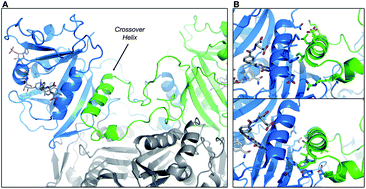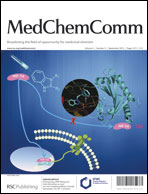Exploring novel strategies for AIDS protozoal pathogens: α-helix mimetics targeting a key allosteric protein–protein interaction in C. hominis thymidylate synthase-dihydrofolate reductase (TS-DHFR)
Abstract
The bifunctional enzyme thymidylate synthase–dihydrofolate reductase (TS–DHFR) from the protozoal parasite Cryptosporidium hominis is a potential molecular target for the design of antiparasitic therapies for AIDS-related opportunistic infections. The enzyme exists as a homodimer with each monomer containing a unique swap domain known as a “crossover helix” that binds in a cleft on the adjacent DHFR active site. This crossover helix is absent in species containing monofunctional forms of DHFR such as human. An in-depth understanding of


 Please wait while we load your content...
Please wait while we load your content...